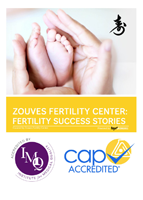
Proud members of the Zouves Fertility Center family.
The prospect of storing gametes, whether eggs or embryos, was until recently good in theory but not great in practice. The original method of freezing that has been used for the last 25 years results in a loss of up to 30% and also significantly devitalized the eggs or embryos in the process. As a result, frozen transfer success rates were always lower than those with fresh transfer.
This all changed over the last decade with the development of the ultra rapid cryopreservation method called vitrification.
Developed in Japan; the survival rates for vitrified eggs and embryos has risen to higher than 95% and the resulting gametes are almost as perfect as they were in the fresh state. This single innovation allows us to consider the option of banking eggs or embryos without compromising success. This opens the door for young women to bank their eggs while they are still in the prime of reproductive life and return many years later to use these vitrified eggs to have a family with their own genetics. They can now “stop the clock,” avoiding the later-in-life possibility of much lower chance of success or even the option of having to do in vitro fertilization (IVF) with egg donation.
In IVF centers with access to advanced laboratory facilities and vitrification, frozen embryo transfer procedures now yield the same or even better success rates compared with the transfer of fresh embryos when the egg provider has herself been stimulated and undergone egg retrieval.
As the success rate with frozen/thawed embryos approaches and surpasses the pregnancy rate in fresh cycles, more and more cycles will now become cycles where embryos are first banked by vitrification, and the patient then returns the following month for a frozen embryo transfer either with natural ovulation or with a controlled frozen transfer.
Vitrification also allows us to increase the chances of success for patients with decreased ovarian reserve (DOR) or patients over age 40 who are not yet ready to pursue egg donation. By setting out to do multiple cycles of stimulation with the banking of unfertilized eggs or day one embryos, one can do two or three stimulations with egg retrieval in rapid succession, bank the day 1 embryos and then thaw them at one time in the future allowing for one single procedure of comprehensive chromosomal screening(CCS), allowing the selection of an embryo that is chromosomally normal and of good quality for transfer. If there are more normal embryos available than are transferred, these can be stored for future use.
The innovation of vitrification of eggs and embryos allows us to consider increasing the chances of ultimate success for patients with DOR by allowing the banking of day one embryos over two or three retrievals followed by the selection of a normal and good quality embryo for subsequent frozen embryo transfer. This also cuts costs due to discounted multiple retrieval plans and the performance of a single CCS procedure.
We have analyzed the first year of doing multiple retrievals and CGH testing and it appears as though the patients who benefit most from the double retrieval are patients with a resting count of less than six with elevated FSH and low AMH levels. These patients generally produce less than 6 eggs in a cycle and often only two or three. When we looked at the patients with better reserve, it appears as though a single cycle with fertilization and testing of blastocysts is better and may shorten the process and make the second retrieval unnecessary.
Experts from Aberdeen University reviewed 11 previous studies, which followed to birth, more than 37,000 pregnancies resulting from the transfer of either fresh or frozen thawed embryos. When frozen embryos were used, there was a 30% lower risk of bleeding during pregnancy, 30 to 40 percent less chance of the baby being born underweight, 20% lower chance of premature delivery and 20% less likelihood of dying in the neonatal period. The study by Dr. Abha Maheshwari at the Aberdeen University was published in the journal, Fertility and Sterility and was presented at the British Science Festival in Aberdeen in 2012. Dr. Maheshwari said: “We found pregnancies arising from the transfer of frozen thawed embryos seem to have better outcomes both for mothers and babies when compared to those after fresh embryo transfer.”
“If pregnancy rates are equal and outcomes in pregnancies are better, our results question whether one should consider freezing all embryos and transfer them at a later date, rather than transferring fresh embryos,” Maheshwari said. The practice has already been adopted by some clinics in Japan, where the process of vitrification was first developed.






